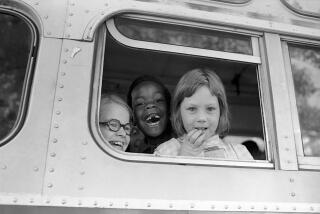The Battle of Paisley Grammar : Scotland Learns a Lesson About School Choice
- Share via
PAISLEY, Scotland — Parents just love the venerable high school called Paisley Grammar, and that drives administrators here crazy with frustration.
In 1981, Margaret Thatcher’s government, always more able to act on conservative doctrine than its counterpart across the Atlantic, imposed a system on Scotland by which students are allowed to choose which school they will attend, no matter where they live--much the same as President Bush would now like to see in the United States.
And today students from towns all around flock to this Victorian, red stone citadel of old-fashioned standards, a citadel, moreover, that the local government had tried its hardest to shut down.
The battle of Paisley Grammar was a classic one between parents and administrators, but because of free choice in schooling (and a helping hand from the prime minister), the parents won.
Many Still Opposed
Choice did not arrive here without a battle, and seven years into the experiment, plenty of Scots still consider it a bad idea. The arguments, in fact, have been precisely the same as those now being heard in the United States, where choice has become the glamour issue in education reform, particularly now that the entire state of Minnesota has embraced it.
But the experience in Scotland has proved some of the key arguments both for and against choice to be wrong.
Opponents, for instance, argued when choice was introduced that the middle class would make the most use of it, and that has not happened.
Proponents, on the other hand, argued that choice would encourage schools to diversify and improve their curricula, and that has not happened either.
A Matter of Perspective
In the meantime, administrators have criticized parents for ignoring the information they provide when making a choice. Parents have criticized administrators for providing information that has little or no real value.
Paisley Grammar is perhaps the best example of how parents and educators see things from different perspectives.
“Kids are coming from miles and miles to Paisley Grammar, so it should be the best school,” says David Dunbar, the acting senior education officer for the district here. “But on the basis of achievement it’s not. Either parents choose to ignore that, or they’re not aware of it.”
“Parents,” he laments, “will only listen to what they want to hear.”
And as parents obstinately send their children to a thriving Paisley, other schools nearby have withered. And again, presaging the American debate, Scottish critics argued in 1981 that choice would enable the better-off students to abandon inner-city schools. Its advocates countered that choice would enable every student to get out of inner-city schools.
Survival Linked to Choice
But in a country where school enrollment is continuing to decline, it’s difficult to find any school that has closed since 1981 simply because it was abandoned by its students. Closures here are as wrenching as they are anywhere in the world, and just about as popular politically. It is easier to say that Paisley Grammar, slated for closing, did not do so because of choice.
Paisley is a textile city just to the west of Glasgow, on the south bank of the River Clyde. It was here, in the late 18th Century, that the Paisley shawl was first manufactured, in an imitation of Persian and Indian designs. Although Scotland has always had a much more comprehensive and egalitarian school system than England, Paisley Grammar developed in the Victorian era as a fortress of quality.
Parents like to think of it that way even today. What do they like about the school, besides its reputation? They like the royal blue blazers that students still wear, in an era when more and more schools are dropping their uniforms. They like the standards of behavior that students are held to. They like the teachers’ way of dressing, in business clothes rather than jeans.
“The image, the ethos of a school depends on a lot of things,” Dunbar points out.
Choice Means Loss for Some
But across Scotland, for every school like Paisley Grammar that is a winner under choice, there are three that are losers, according to a detailed examination of the effects of choice that was carried out by David Strachan and others of Glasgow University five years into the experiment.
Looking in detail at a section of Glasgow with 10 secondary schools, the study found that 63% of the requests for transfers had been to just one school, and that three schools accounted for 93% of all the transfer requests.
“And the children who are left in unpopular schools can be from families where there’s no great interest in education,” says Dunbar, his remarks echoing those heard in Minnesota and elsewhere around the United States where people worry about the losers under choice.
Yet, in 1989, the roof has not caved in on Scottish schools, even those in poor urban neighborhoods. (Of course, in Scotland, schools serving poor neighborhoods actually get more money than those in well-to-do neighborhoods).
Few Exercised Right
For one thing, according to figures compiled by the Scottish Education Department, only about 2% of students around the country have availed themselves of the right to leave their district. That figure, by the way, is about the same as in other European countries with choice.
Choice here, it turns out, has also not become a preserve of the middle class, as many of its critics expected.
The Glasgow University study concluded that most middle class people still choose schools the traditional way--they move to the districts where they want to send their children to school.
Those using choice, on the other hand, are largely from the families of trained manual workers--that is, the most highly skilled blue-collar employees. Of those making transfer requests, 54.5% are from this group, a thin layer of typically ambitious families in a largely socialist country where ambition is generally regarded as an unattractive trait.
Convenience a Main Reason
Through questionnaires and interviews, the study also examined parents’ reasons for requesting transfers. In a sample of urban families, fully 35% of those choosing other schools at the beginning of their children’s secondary career (the equivalent of 7th grade) said they did so for matters of convenience, because the school was closer or easier to get to.
Almost the same number--36%--mentioned “reputation.”
But only 7% specifically mentioned the school’s curriculum, and 4% the quality of teaching, as reasons to transfer. Interestingly, just 10% said they wanted to transfer to avoid the local school, and among the parents of 5-year-olds just entering school, none said they wanted a transfer to avoid the local school.
One of the arguments put forward by choice advocates here was that it would shake up the schools and foster creativity and diversity.
Parents Stress Standards
But educators agree that has not happened. Parents, as the Glasgow University study pointed out, are more concerned with “standards” than with “alternatives.” More than half of those requesting transfers for their children said they were strongly influenced by the school’s exam results (the Paisley Grammar advocates notwithstanding), and educators believe this has actually led schools to be more conformist, more worried about adhering to the standard curriculum, than before.
Has choice resulted in a mixing of people from different economic classes, as the Conservative proponents predicted?
In some areas it has, in others not at all.
In a city that was considered by the Glasgow University study--unnamed, but apparently Aberdeen--one secondary school in an affluent neighborhood, a school with a tradition going back to the 1500s, now has 59% of its students in some grades from outside its zone, most from nearby public housing.
Influx Changes Attitudes
The reaction? One local parent says, “I think people’s opinion of the high school is beginning to change because of the tremendous cross-section that is there. Now, I’m not being snobbish, but I saw some kids the other day and I thought, ‘Good grief, I don’t know why they’re allowed in the door, hair this color and that color.’ They still officially don’t allow makeup but you can’t enforce that kind of individual discipline anymore.”
Administrators here seem to be afflicted with a certain amount of the we-know-what’s-best syndrome, and choice leaves them uneasy or hostile.
One administrator says of choice, “As a parent I like it. As an administrator I hate it.”
Duncan, the acting head of the authority (or district) that encompasses Paisley, has more or less come to terms with choice. It’s the law, after all.
More to Read
Sign up for Essential California
The most important California stories and recommendations in your inbox every morning.
You may occasionally receive promotional content from the Los Angeles Times.













